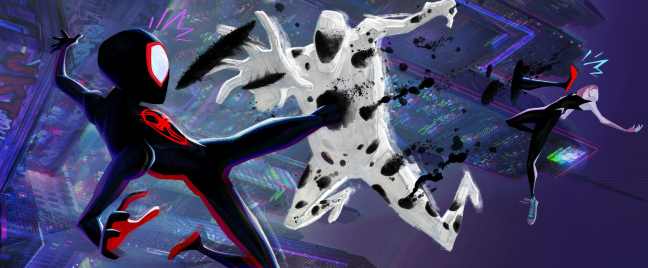
“Spider-Man: Across the Spider-Verse” is awash in stories — its first five or so minutes, an ostensible prologue, is a dynamic tragedy in miniature, and that’s just the first five minutes — all built around an idea one of its characters tosses out during a similarly information-packed voiceover: They’re going to “do things differently.” It’s precisely what the film’s predecessor, the rightly Oscar-winning “Spider-Man: Into the Spider-Verse” did four years ago, taking a well-worn concept (a Spider-Man origin story? again?) and turning it into an actual masterpiece built on a wealth of stories, new and old, told with legitimate energy and innovation. And it’s what Joaquim Dos Santos, Kemp Powers, and Justin K. Thompson attempt to replicate in their sequel, an aim that pays off mightily.
Set a year after “Into the Spider-Verse,” “Across the Spider-Verse” makes a pit stop with Gwen Stacy (voiced by Hailee Steinfeld) before checking in with our hero Miles Morales (voiced by Shameik Moore) and further pulling tight the duo’s special bond as Spider-Woman and Spider-Man, respectively. Since we last left her, Gwen’s universe has grown still more complicated — girl, aren’t they all? — but other issues beyond her own web-based problems have kept her from skipping through the multiverse to see Miles in his. Per that packed prologue, Gwen soon finds herself fighting alongside Miguel O’Hara (a vampire ninja Spider-Man, voiced by Oscar Isaac) and Jessica Drew (a pregnant, motorcycle-riding Spider-Woman, voiced by Issa Rae), who arrive in her universe to essentially clean up some multiverse-threatening collateral damage from all the wild stuff that happened in the first film. Eventually, the bad-ass duo take her into their crime-fighting fold when they realize how dangerous the world has become to ol’ Spider-Gwen.
They’re part of the Spider-Society, and while we won’t get a real sense of the dazzling scope of that particular group — all Spider-People, all the time — until the film’s full-to-bursting third act, it’s very much worth the wait. (But we won’t even wait to say more in the context of this review, because it’s simply too good. It would be impossible to name even a fraction of the different Spideys who pop up throughout the film at large and the Society in particular after just one viewing — every frame involving the various webheads is packed with jokes, gags, entertainment, and information — but suffice it to say, if there’s a particular flavor of Spider-Man you’re looking for here, you’re probably going to get him/her/them. LEGO Spider-Man! Spider-Man as a car. Spider-Cat! Spider-Cowboy! Spider-uhhh-T.Rex! Spider-Everyone, OK? Now back to it.)

“Spider-Man: Across the Spider-Verse”Sony Pictures Animation
In Miles’ own world, things are going mostly alright. He’s a bit stretched by the whole being-Spider-Man and also a totally normal teen thing, but what hasn’t Spidey endured in the course of this iconic tale? When a wacky new baddie shows up (his name is Spot, he’s voiced by Jason Schwartzman, he is perfect), Miles takes this particular “villain of the week” in stride. That’s just about the worst thing he could do to Spot, who is filled with ineffectual rage, an insatiable hunger to pump up his own powers, and a burning desire to punish Miles.
“I am your nemesis!” Spot yells at Miles, who spends the majority of their first battle texting with his parents. That means it’s far too late when he realizes that Spot actually is someone to be afraid of.

“Spider-Man: Across the Spider-Verse” Sony Pictures
The multiverse is already in a tenuous state, and Spot’s growing ability to create his own portals, skipping and jumping between worlds at a whim, is about to crack it even further. And that’s just one part of this story, written by producers Phil Lord and Chris Miller (plus “Shang-Chi and the Legend of the Ten Rings” scribe David Callaham) and content to grow and mature right alongside Miles.
“Into the Spider-Verse” was astute and funny, complicated and emotional, unique and daring, and its sequel only grows and expands on those aims. If the first film showed what superhero movies could be, “Across the Spider-Verse” goes even further: It shows what they should be. In a genre built on the literally super and special, these films are unafraid to stand out and do something truly different, something that pushes the limits, to show the genuine range available to this subset of stories and feel damn good in the process (and look, dare we say, even better).
Much of that is surely due to their distinct animation style, which in its second iteration, looks even more stunning, more tactile, more real in its distinct unreality, because all that jaw-dropping animation is truly in service to the story and its emotions. Colors and shadows, a flick of an eye and the flex of a hand, comic book panel-styled intertitles and zingy asides, all of it exists to advance the tale, not distract from it. Action sequences unfold with their own kinetic logic yet remain fully coherent (something the vast majority of our current crop of live-action blockbusters can’t claim) and engaging to the point that audiences might forget to breathe during them.

“Spider-Man: Across the Spider-Verse”Sony Pictures Animation
And Dos Santos, Kemp, Thompson, and their mighty band of animators don’t skimp on them at all, every action-packed sequence — from a lovely bit that sees Miles and Gwen reuniting while webbing through the city, to a last-act chase that involves a dizzying amount of players and goes on for twice as long as most movies would dare — is still thrilling from top to bottom. It’s an eye-popping visual feast and a satisfying one to boot. Why can’t all blockbusters even attempt half as much as what “Across the Spider-Verse” puts, so lovingly and so smartly, into all of its setpieces?
When Gwen finally arrives back in Miles’ world, she’s forced to hide nearly all of her motivations from her Spider-BFF, who mostly just wants to hang out with her (and, later, his delightfully sarcastic mentor, Peter B. Parker, voiced by Jake Johnson) and can’t quite see just how much his world (his universe) is hanging in the balance. Miles has always been exceptional to the point of being the exception, and while he might believe that being part of something bigger, perhaps in the form of the Spider-Society, is the ticket, he’s about to learn that’s simply not the case. As high-flying and heart-pumping as Miles’ next chapter is, it also cleverly moves toward a series of massive reveals — the kind that feel earned, the kind that feel personal and inevitable, a far cry from the what-if-the-whole-universe-was-gonna-be-destroyed boredom and uniformity that plague so much of this genre — that speak to the distinctive pleasures of this franchise.

“Spider-Man: Across the Spider-Verse”Sony Pictures Animation
What is Miles really going up against? Nothing less than — pause to really let this part sink in — the canon itself. No, really, the very thing that Miguel O’Hara and Jess Davies and Gwen and Peter B. Parker and the rest of the Spider-Society are tasked with holding together is the canon. For comic book fans, the implications are clear: the canon is made up of all those accepted, classic, traditional stories, the backbone of the superhero universe, the stuff you don’t want to mess up or go against or break outright. Miles Morales, from his very creation both in the comic books and on the big screen, is a new twist on the canon. A Spider-Man who isn’t Peter Parker? Who is from Brooklyn? Who is mixed race? If you’re still clutching your pearls over the creation of these kinds of characters or review-bombing a film because it dared to cast a person of a different color or gender than you wanted or yelling about this sort of demented ideology on social media or whatever it is you do with your precious time on Earth, “Across the Spider-Verse” has got a hell of a message for you. Breaking the canon? You gotta do it.
That’s not something Miguel and company (with some notable exceptions, including the Daniel Kaluuya-voiced anarchist Brit Spider-Punk) are ready to hear, if only because they’ve become convinced of the power of Spider-Man’s mythology to quite literally hold the multiverse together. Miles, at first purely on accident and then totally by force of will, cannot abide by living the same beats as the rest of his brethren, and that puts him on a staggering crash-course with just about everyone and everything. Miles has always broken the mold, and once he sees the mold itself, he’s gotta do it again, his way.

“Spider-Man: Across the Spider-Verse”Sony Pictures Animation
And if all of this sounds like a tremendous amount to pack into a single film, there’s the rub. In a somewhat disappointing twist, “Across the Spider-Verse” isn’t really a single film, it’s instead one-half of a planned two-film sequel. The decision to split the sequel into two films seems to have been lost on plenty of fans. Lord and Miller announced the two-part sequel, complete with “Part One” and “Part Two” title addendums, back in December 2021. By April 2022, the two films had been renamed “Across the Spider-Verse” and “Beyond the Spider-Verse,” a move that seems to have caused the bulk of the confusion. Even in this critic’s well-attended screening, the end reveal that this story is very much not over was met with cocked heads.
It’s a heck of a problem: to simply have too much good stuff to stuff into just one film, leaving the audience on tenterhooks for when they can see this particular superhero story actually wrap up (it’s March 29, 2024, by the way). It’s the only thing about “Into the Spider-Verse” that feels familiar, too, a choice that puts it on the “Fast X” or “Harry Potter” or “The Hunger Games” route, with one exception: this conclusion will surely be worth the wait.
Grade: A-
Sony Pictures Animation releases “Spider-Man: Across the Spider-Verse” in theaters on Friday, June 2.


